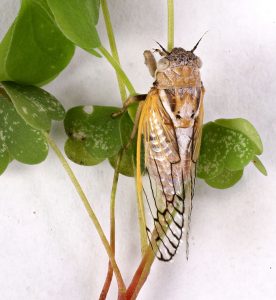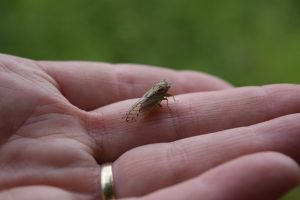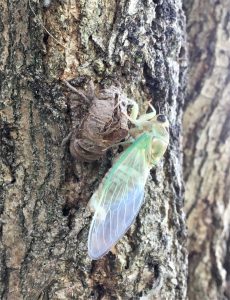The Buzz About Cicadas
They started this year more-or-less right on schedule. The first week of July, in the heat of the afternoon you could hear a pulsing buzz in the treetops. The first Dog-day cicadas of the year are singing. Cicadas are a very successful group of insects (if you measure success in terms of diversity). Nineteen species of cicada are known from Illinois, 170 species in the US and Canada, and about 3000 species worldwide. Some cicada species are habitat specialists. In the Land of Lincoln we have a prairie cicada, swamp-loving species, and bush cicadas.

On a few high-quality hill prairies in Monroe County we have Illinois’ only populations of the smallest cicada species in North America, the Aridland Cicada (Beameria venosa). These cicadas are noted for the black veins on their wings. They seem to prefer scurfy pea on which to deposit their eggs, but researchers hope to learn more about how long they remain underground and if populations in Illinois and Missouri are connected in some way.

In some parts of the country cicadas are mistakenly referred to as “locusts”. While both are large insects, locusts are a type of grasshopper, and cicadas belong to a very different group called “true bugs” that lack chewing mouthparts (not all insects are bugs, but all bugs are insects). As a group, adult cicadas all have very prominent eyes, stout bodies, and large wings. Young cicadas, called nymphs, live in the soil for years and use their long tubular mouth to pierce the roots of plants and feed on sap. When Nature calls them, the nymph burrows out of the soil, climbs up the nearest plant or suitable structure, and transforms into the more familiar winged adult. Most adult cicadas live for only a few weeks and never even feed. The prime directive of the adult is to reproduce before their short adult live is over. Males produce a loud courtship song to attract females. Mated females use a curved, pointed appendage called an ovipositor to lay eggs under the surface of a plant stem or twig. The newly hatched nymphs then move down the plant and burrow into the soil to begin their long period of growth and development.

Cicadas species follow one of two major lifecycle strategies; annual vs periodical. Annual cicadas, like Dog-day cicadas, spend an average of two to four years in the soil as a nymph. The generations are staggered so that some individuals become mature every year. The annual species are solitary and will emerge throughout the summer. Periodic species follow a 13- or 17-year life cycle. After growing in the soil for more than a decade, broods emerge in synchrony as a strategy to overwhelm potential predators. You may have been following the news reports about Brood X cicadas emerging by the millions in parts of the eastern US. The next major periodical cicada event we can expect in southwestern Illinois is Brood XIX, a 13-year species due in summer 2024. By the way, we are also expecting a full solar eclipse on the 8th of April 2024, so make plans to see two natural wonders in one year!
CLIFFTOP, a local nonprofit organization, is focused on preserving and protecting area blufflands.
A version of this article appeared in the July 14, 2021 edition of the Republic-Times.
©2021 all content rights reserved Clifftop NFP
Comments are currently closed.
